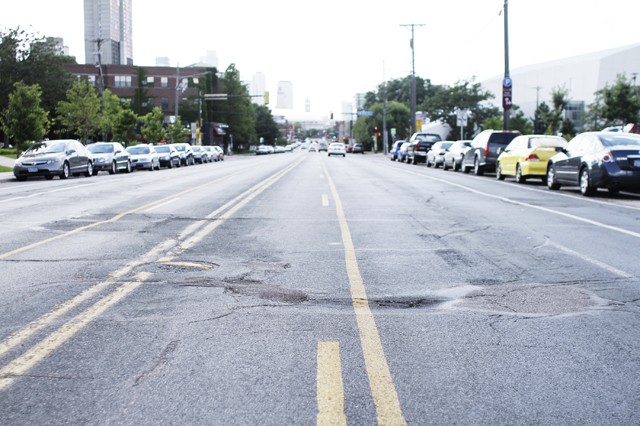As construction moves forward on the Central Corridor Light-Rail line, city and county officials are exploring how the track could boost development near the future West Bank station.
Minneapolis and Hennepin County have brought together a group of experts to study the area surrounding the future station — which will be located on Washington Avenue between 19th and Cedar avenues — and determine which future buildings and businesses would work best for the neighborhood.
“We want to look at how the light rail will potentially encourage more development on the West Bank,” said Cam Gordon, Ward 2 City Council member. “We want to find out, ‘Could we take better advantage of all of this space?’”
The study ranges from architects creating renderings of buildings for future businesses to engineers studying traffic patterns to real estate experts tracking the neighborhood’s market, Haila Maze, the principal planner on the project, said.
The area around the new light-rail station poses physical challenges due to the sloped landscape and cramped space, Maze said, and new developments also face a struggling economy.
Additionally, West Bank residents and existing businesses will have to endure multiple construction projects at once.
On top of the light-rail construction, plans are in place to begin construction on the two main arteries of the neighborhood. The city will tear out and rebuild Riverside Avenue during 2011 and 2012, and the county will resurface Cedar Avenue this year.
Officials hope to coordinate the projects so that the bulk of Riverside Avenue will be finished by the time light-rail construction hits the West Bank, Gordon said.
Residents, business owners and officials disagree on how to best go about the construction, he said; about whether it should be quicker but involve more street closures, or take longer while keeping most of the roads open.
But all of that isn’t a major concern for Rod Johnson, owner of Midwest Mountaineering, an outdoor clothing and equipment store on Cedar Avenue.
“Construction is always tough because it makes it harder to get to the businesses,” he said. “But after it’s done in a year or two, it goes away and the streetscape is nicer.”
Seth Jacobs, who works at The Hub Bike Co-op, isn’t so optimistic. It’s difficult for businesses to bring in new customers when “there’s not a clear-cut path to your door,” he said.
Overall, though, many business owners think the light rail and the development it will spur will benefit the area, Johnson said.
“We’re really excited about it coming here and we think it will improve business,” Johnson, a longtime West Bank area resident, said. “It would be really cool to see more development in the area.”
While the line and development will contribute to the neighborhood, Jacobs said he worries about current businesses being left in the dust.
“It’s kind of a double-edged sword,” he said. “We’d love to see new development, but at the same time, why don’t we take care of the businesses that are already here first?”
City and county officials are working to keep current residents and business owners in the loop, Maze said.
“We want to add new businesses and residences, but we’re not looking to diminish or damage the character of the neighborhood at all,” she said. “We will support and enhance what the existing business community is already doing.”
The study group held a public meeting earlier this summer to discuss preliminary findings and ideas. It plans to hold another in late August or September, Maze said.
The county and city have more of an opportunity to shape future development in the area because they own the land, she said, and can make sure new businesses complement the existing neighborhood.
“I think there’s exciting potential to reconnect parts of neighborhood,” Gordon said. “We can use this project to unify the area.”
The city and county began preliminary work on the project in May after receiving a $60,000 grant from the Central Corridor Funders Collaborative, a group of local and national funders working to ensure neighborhoods and businesses can benefit from the new line.
The funding is solely for planning purposes and doesn’t finance any actual construction, Maze said. Rather, the goal is to come up with a list of “buildable projects” that could fit in the area, and then hire developers to design and build the structures, she said.
The city and county are trying to make the best of the study and the funding and gather as much input as possible from residents and businesses, Maze said.
“It’s a pretty rare opportunity, because you don’t have this much attention and resources directed in one area very often,” she said. “This is a big chance, and we want to make the most of it.”








